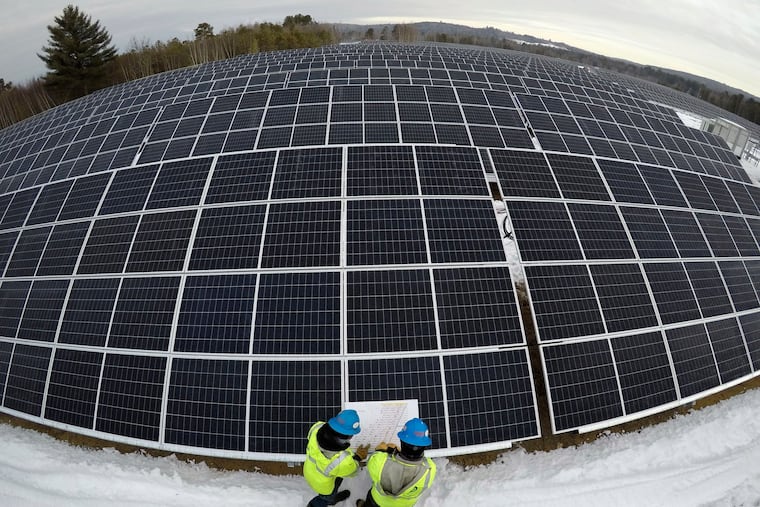Pennsylvania plans to generate 50% of government building energy through solar, Wolf says
Gov. Tom Wolf announced a plan to produce half of all the state government’s electricity through seven new solar energy arrays totaling 191-megawatts.

Gov. Tom Wolf announced Monday a plan to purchase half of all electricity used by Pennsylvania’s government buildings from solar energy arrays to be built on farms sprawled across six counties.
The administration says the 191-megawatt deal is currently the largest commitment by any state government in the U.S. The arrays, an arrangement of solar panels, should begin producing power by Jan 1. 2023.
The power will be generated by seven arrays located on 1,800 to 2,000 acres of farmland in Columbia, Juniata, Montour, Northumberland, Snyder, and York Counties where farmers have signed 30-year leases. The electricity generated from their land would be roughly enough to power 33,000 homes.
The arrays will be built and owned by Lightsource BP, a global company with an office in Philadelphia. Under the deal, Pennsylvania has signed a 15-year agreement to purchase the power through Constellation, an Exelon company. State officials said the average it will pay for power under the agreement is about 5 cents per kilowatt hour, cheaper than the last 10-year average the state paid for traditional supply.
Officials said the agreement, part of Wolf’s GreenGov initiative, has little up-front cost to taxpayers, and that the solar arrays will generate tax revenue.
The Project to Utilize Light and Solar Energy, or PULSE, will create 400 jobs, with 80% of the workers hired locally, officials said, with most of the jobs coming from 18 months of construction. Only a handful of jobs will remain for maintenance and operations once the arrays are complete.
“Pennsylvania has been a national energy leader for more than 100 years,” Wolf said in a statement. “As we continue to diversify our grid with clean renewable sources of energy, we want to maintain Pennsylvania’s leadership position and bring the associated economic, health, and environmental benefits to all Pennsylvanians.”
Officials say the energy from the solar arrays will supply 100% of electricity for buildings across 16 state agencies, which is the equivalent of about half the electricity used by state government. The transition to renewable energy sources is intended to lower carbon dioxide emissions statewide by 157,800 metric tons annually. Solar now supplies less than 1% of electricity in the state, where power is dominated by natural gas from the Marcellus Shale.
Wolf has issued an executive order on climate change setting a goal of lowering greenhouse gas emissions by 26% by 2025 and 80% by 2050, compared with 2005 levels.
Pennsylvania DEP Secretary Patrick McDonnell cited the 2020 Pennsylvania Climate Impacts Assessment, which found the state’s average temperature has climbed nearly 2 degrees Fahrenheit since 1901, average annual rainfall has risen 10%, and extreme weather events have increased.
The report projects that by 2050 every county will be 4.9 degrees hotter than in 2000, while average rainfall will continue to increase 8% to 12%.
“Reducing greenhouse gas emissions is crucial to slowing climate change and protecting our health and safety, environment, and economy,” McDonnell said.
He said, however, that “clean energy is a leading creator of quality jobs” in the state. Data show solar energy jobs were growing at an annual rate of 8.3%, much faster than the overall statewide job growth rate of 2%.
Cindy Adams Dunn, secretary of the commonwealth’s Department of Conservation and Natural Resources, said state forest land now contains 4,700 buildings. She said the DCNR has installed 16 solar arrays in the past five years to help power them, and plans 18 more arrays in the next two years.
Environmental groups welcomed Pennsylvania’s solar power purchase agreement.
“Going solar is a triple win for Pennsylvania: it’s good for our planet, good for our health, and good for our pocketbooks,” said David Masur, executive director of the nonprofit advocacy group PennEnvironment. “This smart decision is a stark reminder of the opportunity offered by going solar. Harnessing more of the sun’s energy means cleaner air, a more stable climate, more resilient communities and an energy source we can depend on that’s virtually pollution-free.”
PennFuture’s Rob Altenburg, called the agreement “both historic and sorely needed” to reduce climate change.
Mark Szybist, with the Natural Resources Defense Council said, “Pennsylvania is showing the rest of the nation how to fight climate change, create jobs, and save taxpayers money — all at the same time.”
State Sen. Gene Yaw, a Republican from Williamsport, and chairman of the Senate Environmental Resources and Energy Committee, however, took issue with the plan by Wolf, a Democrat.
“I have said repeatedly, I favor a diverse energy portfolio,” Yaw said in a statement. “I am not against any energy source. What I am against is the failure to recognize what ‘clean’ energy really entails. There is a manufacturing process, which is totally ignored. Further, the intermittent nature of wind and solar requires a duplicate generation system powered by coal, gas or nuclear.”
He said solar panels require far more land to produce the equivalent amount of gas-fired plants.
“There is a growing public awareness that so-called environmentally friendly energy sources like solar and wind are not so environmentally friendly,” Yaw said.
He added that carbon dioxide emissions from fossil fuel power generation in Pennsylvania has been reduced by 38% since 2002. That’s largely come from the transition away from coal to natural gas, of which Pennsylvania is the second largest producer in the U.S., behind Texas.
“When are we going to stop apologizing for the abundant resources we have?” Yaw asked.